The Variable Moving Average (VMA) dynamically adjusts its own smoothing period to the changing market conditions based on a Volatility Index (VI). While any VI can be used, in this article we will look at how the VMA performs using an Efficiency Ratio (ER). This is identical to the modified CMO that Tushar S. Chande suggested be used in his October 1995 article in Technical Analysis of Stocks & Commodities – ‘Identifying Powerful Breakouts Early‘.
The ER-VMA requires two user selected inputs: An Efficiency Ratio Period and a VMA period. We tested trades going Long and Short, using Daily data, taking End Of Day (EOD) and End Of Week (EOW) signals~ analyzing all combinations of:
ER = 10, 20, 40, 80, 126, 252
VMA = 1, 2, 3, 4, 5, 6, 7, 8, 9, 10
The ER lengths were selected due to the fact that they correspond with the approximate number of trading days in standard calendar periods: 10 days = 2 weeks, 20 days = 1 month, 40 days = 2 months, 80 days = ⅓ year, 126 days = ½ year and there are 252 trading days in an average year.
The VMA periods were selected after preliminary tests showed that when combined with the different ER lengths they resulted in median smoothing periods between 6 and 207 days; a range that should capture the best results based on what we know from previous research into moving averages.
A total of 240 different averages were tested and each one was run through 300 years of data across 16 different global indexes (details here).
Download A FREE Spreadsheet With Raw Data For
All 240 ER-VMA Long and Short Test Results
.
ER Variable Moving Average EOD vs EOW Returns:
.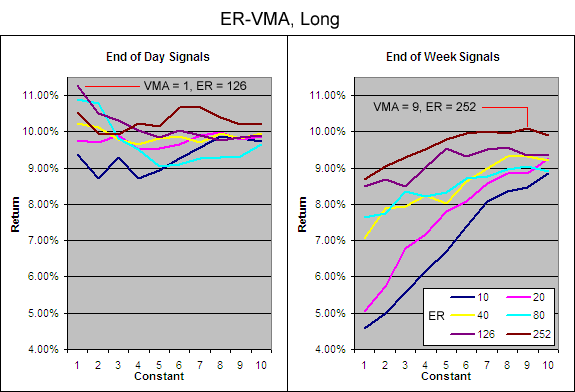
.
As with previous VMA test, every single ER-VMA using EOD signals managed to outperform the average buy and hold annualized return of 6.32%^ during the test period (before allowing for transaction costs and slippage).
Clearly the ER periods of 126 and 252 produced the best results using both EOD and EOW signals. This echoes previous results on other ‘intelligent’ moving averages. The 126 Day ER-VMA with a constant of 1 stands out as the best performer with EOD signals while the 252 Day ER-VMA with a constant of 9 was the best when taking EOW signals. (The results on the short side reiterate this).
It is interesting to note that the returns hold up quite well when using EOW signals on a 252 ER so lets take a closer look at the how the probability of profit and trade duration compares for EOD and EOW signals:
.
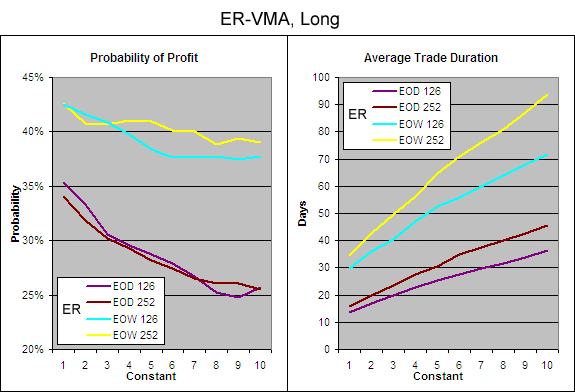
.
Clearly there is a large jump in the probability of profit and the average trade duration when using EOW signals; both are highly desirable characteristics especially if they can be achieved without sacrificing too much return.
.
Best EOD Efficiency Ratio Variable Moving Average
.
 .
.
I have included on the above chart the performance of the 126 Day FRAMA, EOD 4, 300 Long becuase so far this has been the best performing Moving Average. The 126 Day ER-VMA, EOD 1, Long produced almost identical results to the best that the FRAMA could produce but still under performs slightly (The same is true on the short side). Plus there are other little things that go against the 126 Day ER-VMA, EOD 1 like a slight increase in the biggest loss and not turning a profit on the Nikkei 225.
.
126 Day ER-VMA, EOD 1 – Smoothing Period Distribution
.
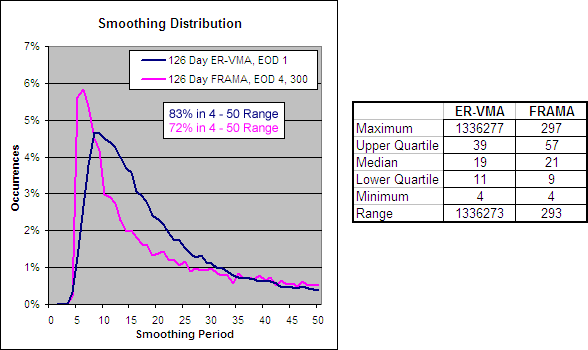 .
.
Looking at the smoothing distribution you can see it is quite similar to the FRAMA but with a lower median and a MASSIVE range.
.
126 Day ER-VMA, 1 – Alpha Comparison
.
To get an idea of the readings that created these results we charted a section of the alpha for the 126 Day ER-VMA, 1 and compared it to the best performing FRAMA to see if there were any similarities that would reveal what makes a good volatility index:
.
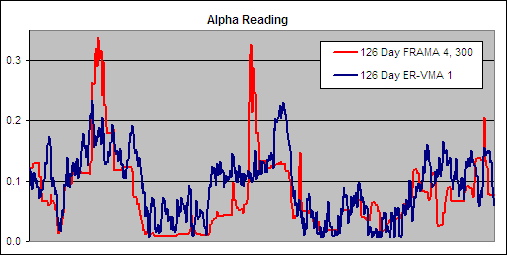
.
The alpha does have a very similar pattern for both the 126 Day FRAMA 4, 300 and the 126 Day ER-VMA 1 and this further helps to explain why their performance is so similar. Notice however that the FRAMA is far less volatile. It is always preferable to work with indicators that generate clean readings with low levels of noise assuming they still produce good results.
.
Best EOW Efficiency Ratio Variable Moving Average
.

.
I have included on the above chart the performance of the 252 Day FRAMA, EOW 40, 250 Long becuase so far this has been the best performing ‘slower’ Moving Average. The 252 Day ER-VMA, EOW 9, under performs by a small amount by almost every measure but it does offer a longer average trade duration of 86 days compared to 63 days for the FRAMA. This makes the 252 Day ER-VMA, EOW 9 a very strong candidate as the best ‘slower’ moving average although its performance on the short side under performs by a slightly greater margin.
.
252 Day ER-VMA, EOW 9 – Smoothing Period Distribution
.
 .
.
Looking at the smoothing distribution for the 252 Day ER-VMA, 9 you can see that it is far more spread out with just 33% of its the periods covered in the first 50 data points while the same range covers 82% for the FRAMA. It also has a much higher median smoothing period of 119 compared to 52 for the FRAMA which explains why it has a longer average trade duration.
.
252 Day ER-VMA, 9 – Alpha Comparison
.
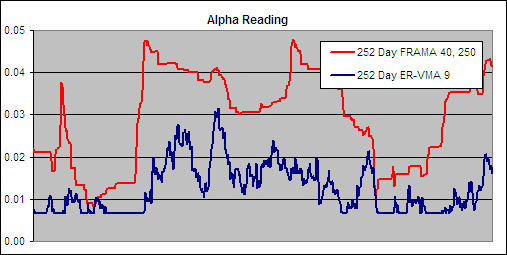 .
.
This time we see that the alphas are very different but once again the FRAMA is far less volatile. Remember the higher the reading the faster the resulting smoothing period; the ER-VMA stays much lower than the FRAMA which results in a slower average.
.
Conclusion
.
The ER-VMA produces some impressive returns and gives the FRAMA a good run for its money. For a ‘fast’ moving average the 126 Day FRAMA, EOD 4, 300 is definitely superior to the 126 Day ER-VMA, 1 because it outperforms by almost every measure and is guided by readings (D) that are far less volatile.
For the ‘slower’ moving average it is more difficult to select the winner. I like the fact that the 252 ER-VMA, 9 has a much more even distribution of smoothing and a longer average trade duration. However it is unfortunate that there is so much more noise in the readings (ER) that guide it. The ER-VMA certainly warrens mention and perhaps further research but based on our findings so far the FRAMA remains slightly superior in almost every way.
Want to use this indicator? Get a free Excel spreadsheet at the flowing link under Downloads – Technical Indicators: Variable Moving Average (VMA). It will automatically adjust to one of many different VIs that you can select including the Efficiency Ratio used in this article.
.
For more in this series see – Technical Indicator Fight for Supremacy
.
- ~ An entry signal to go long (or exit signal to cover a short) for each average tested was generated with a close above that average and an exit signal (or entry signal to go short) was generated on each close below that moving average. No interest was earned while in cash and no allowance has been made for transaction costs or slippage. Trades were tested using End Of Day (EOD) and End Of Week (EOW) signals on Daily data. Eg. Daily data with an EOW signal would require the Week to finish above a Daily Moving Average to open a long or close a short while Daily data with EOD signals would require the Daily price to close above a Daily Moving Average to open a long or close a short and vice versa.
- ^ This was the average annualized return of the 16 markets during the testing period. The data used for these tests is included in the results spreadsheet and more details about our methodology can be found here.